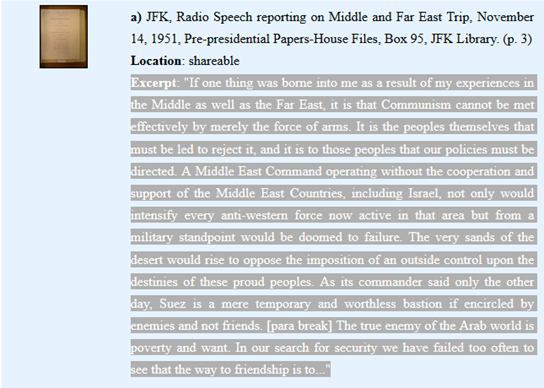DOI: https://doi.org/10.59350/msdgj-6yf95
Sharing qualitative data produces many benefits: shared data can contribute to making the research product in which they were originally deployed more easily understandable and interpretable, they can be analyzed by other researchers, and they can be used for pedagogical purposes. QDR is very interested in promoting all of these uses of shared data.
We recently discovered that Robert Adcock (School of International Service, American University) had put a data project on QDR to pedagogical use. He described his experience in the following way (personal communication with Diana Kapiszewski, cited with his permission):
This semester I am teaching a ‘Historical Methods in International Relations’ course, where historical is understood principally in terms of using primary sources (...). We devoted a full class day during the section of the class on finding and using primary sources to working with Saunders’ chapter on QDR.
Robert refers to the active citation compilation that Elizabeth Saunders (Political Science, George Washington University) created for her chapter on John F. Kennedy in her book Leaders at War: How Presidents Shape Military Interventions.
“Active citation” is a transparency technique developed by Andrew Moravcsik (2010, 2012, 2014) that entails digitally enhancing the citations – in-text references, footnotes, and/or endnotes – in a piece of scholarship based on qualitative or multi-method research. “Activated” citations are hyperlinked to a Transparency Appendix (TRAX) where excerpts from the underlying data source and annotated versions of the citations appear. In addition, when the actual sources that underlie the activated citations can be legally and ethically shared, the TRAX includes hyperlinks to these sources. Together, the TRAX and the underlying data form an active citation compilation (ACC).
In the chapter on Kennedy, Saunders argues that Kennedy saw a central source of threats to US security in the internal politics of other states. She uses a wealth of archival sources from JFK’s pre-presidential papers to show that he held such beliefs prior to his presidency; they were not just rhetorical devices to justify otherwise motivated actions.
As part of her ACC, Saunders makes available digital images or PDFs of almost 50 primary sources. Many of her sources are from the rarely used pre-presidential papers. We offer here one example – a 1951 speech by JFK:

Let’s return to Robert’s classroom and see how he used Saunders’s data project in his teaching.
I broke the class up into 10 groups of 2-3 people, and then divided up the footnotes of the piece across the groups. Each group then clicked through to look at the sources on QDR to identify the types of sources being used and to evaluate how well the claims made in the text (and the quotes used there) were supported when looked at in light of the full primary texts. I then had each group report back to the class on what they had found so that we could create collectively an aggregate overview of the kinds of sources used and overall evaluation of the quality of the evidential support for the argument.
In the ongoing debates about transparency in the social sciences, the role that transparency can play in allowing for the evaluation of research is frequently put front and center. More transparent research allows readers to make sure that rules concerning data generation and analysis were followed and/or that results can be replicated. Robert’s classroom exercise instead centers on something different, and equally important: the ways that transparent research can help us learn about – and teach about – the research process as well as help us to better understand research.
So, how did it go? Says Robert:
I had high hopes for this intellectually, but was a bit worried technically about how having them all need to log in to QDR to be able to do the exercise in class would play out. Perhaps because they are all more comfortable with technology than I, there actually turned out to be no hitches on the technical side of things at all. And intellectually it turned out even better than I expected. My key goal was to prep them to write a paper reviewing the kinds of primary sources they were using in their own research papers and issues of selection and interpretation pertaining to each of those types of sources. They reported getting a lot [out] of that assignment, and I thought it moved them along a lot also, and I'd like to think that the hands-on QDR exercise was key to the success of that subsequent assignment.
Needless to say, we couldn’t be more pleased with this. So how about you? Are you using qualitative data in your classroom? Are you interested in exploring ways to do so? We want to hear from you! E-mail us at qdr@syr.edu.